Famicom Disk System
Top 10 Best Famicom Disk System Games of All Time!
In an effort to curb the manufacturing costs of cartridges, Nintendo released the Famicom Disk System in 1986. This system plugged into the Famicom via the cartridge port and supported proprietary double-sided floppy disks. Games for the Famicom Disk System had several advantages over standard cartridges. They were cheaper to manufacture, they provided ample storage space for developers, and they allowed users to save their progress. While the system was known for an assortment of text-based adventure games and unlicensed titles, its library was by no means limited to quirky titles. In fact, many of Nintendo’s biggest releases from the mid ’80s were initially developed on the FDS; including Metroid, Kid Icarus, The Legend of Zelda, and Castlevania. As cartridge prices began to drop and battery technologies became more efficient, the advantages of the Famicom Disk System became increasingly less defined, so most of the best games for the system were also released in cartridge form. With that in mind, this list recognizes the best Famicom Disk System games that were never released in cartridge form for either the Famicom or the NES.
10
Yōkai Yashiki
1987
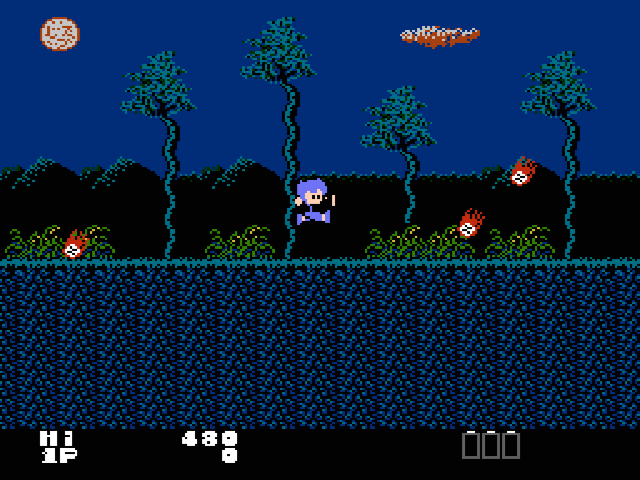
Yōkai Yashiki was originally released by Casio on the MSX, but Irem’s Famicom Disk System version could be described as an enhanced port and featured enhanced graphics. Yōkai are a class of supernatural beings in Japanese folklore, and Yōkai Yashiki roughly translates to “Monster House.” Appropriately, the game takes place in numerous haunted house-like stages that are loaded with hidden passages, invisible ladders, and secret entrances. It’s almost like your exploring Webster’s house! The game is a simple platformer that involves a bit of exploration and lots of jumping. Naturally, you’ll also encounter many ominous beings along the way. Your character is equipped with a flashlight (a must for any ghost hunter) that effectively works as a projectile weapon, and you’ll be able to find battery power-ups along the way to increase its potency. Yōkai Yashiki really embraces its ghostly theme. The environments are eerie, the enemies are creepy, and the music is downright spooktacular.
9
Yū Maze
1988
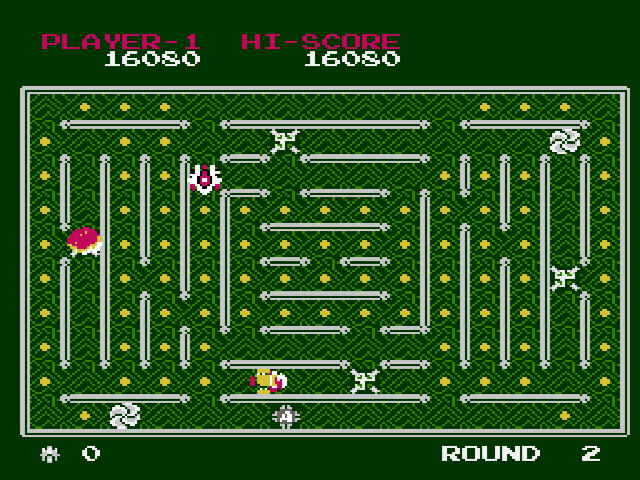
Following the success of Pac-Man, maze-based “dot eating” games began to flood the market. The format was a pretty easy one to emulate, and a lot of good games were released in its wake. Taito’s Yū Maze (also known as Raimais in arcades) was released just as Pac-Man fever was beginning to fade, but it was arguably the most ambitious game in its genre. The game puts players in control of a rad chick who rides a futuristic motorbike through various mazes. The thing that separates Yū Maze from similar games is the sheer amount of power-ups available. You’ll find items that will slow down your enemies, open up gates to the next level, or give you the ability to shoot lasers. You’ll also get assistance from a weird alien creature who can increase your speed, improve your armor, or grant invincibility. There are over 30 mazes to explore which are filled with tunnels, shutters, teleporters, and relentless enemies that are trying to destroy you. Yū Maze is one of the most overlooked Famicom Disk System games and was the only home port of Raimais that existed until a PlayStation 2 version launched 17 years later. The FDS port was missing the boss fights from the arcade game, but the ability to create your own levels made up for it.
8
Knight Move
1990
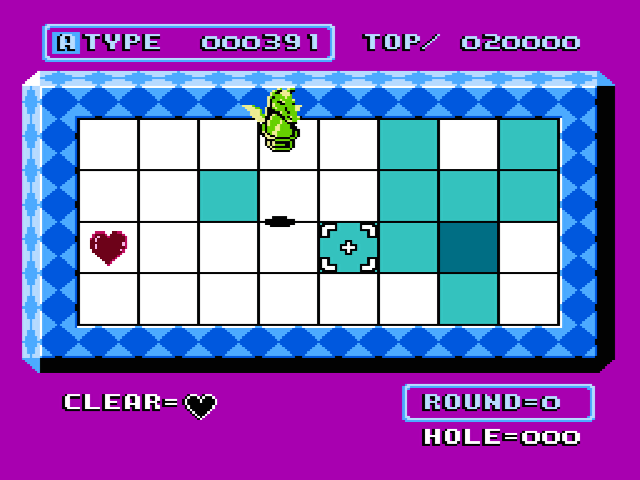
Knight Move is a unique puzzle game designed by Tetris creator, Alexey Pajitnov. It’s an appropriate name, given that the entire game is based around the movements of the knight pieces from chess. Controlling a knight piece, players move around grid-based stages and attempt to shatter all of the tiles on the board by jumping on them. Players can only make moves that would be legal in chess, so their movements are restricted to L-shaped patterns. After tiles are shattered, players have to avoid falling into the pits that are left in their place. Most puzzles become easier as you put more and more pieces together, but Knight Move becomes increasingly difficult with each shattered tile since players have fewer and fewer spaces they can safely move to. I was surprised at how much depth could be given to a game based around a single chess piece, but the game does a great job of highlighting how much range the piece has. You’ll need to plan your moves out in advance if you want to succeed in Knight Move, which seems appropriate for a game inspired by chess. If you become bored with the single-player mode, the game also allows you to compete with a second player. Knight Move was one of the last games Nintendo released for the Famicom Disk System and was largely ignored, but a similar game called Knight Moves was released in 1995 for Windows.
7
Esper Dream
1987
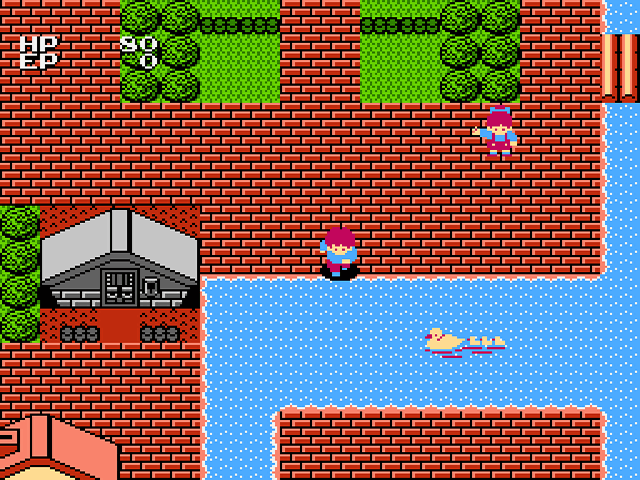
Esper Dream is an RPG that follows the adventures of a young boy who is transported into his favorite storybook. RPGs were common in the 1980s, but Konami tried to do things a little bit differently with Esper Dream. The game has a proper experience system and your character’s stats will increase as the game progresses, but the battle system is anything but typical. Most RPGs from the era implemented random battles, but players can see their enemies in Esper Dream and avoid them altogether if they so desire. When you do encounter an enemy, the game transitions to the battle screen as you expect. The battles are not menu-driven, however. Rather, they play out like an overhead action game. During the game, players will learn new abilities that help them both in and out of battle – including spells that light up dark areas and a teleportation technique that can warp you to the first village. The game puts its storybook theme to good use with the inclusion of interesting environments that include forests, floating palaces, and computer labs. The game requires a bit of grinding so you’ll need some patience if you want to fully enjoy it, but it was an interesting take on a genre saturated with uninspired Dragon Quest wannabes. If nothing else, it’s refreshing to play a 1980s RPG that doesn’t revolve around medieval tropes.
6
Arumana no Kiseki
1987
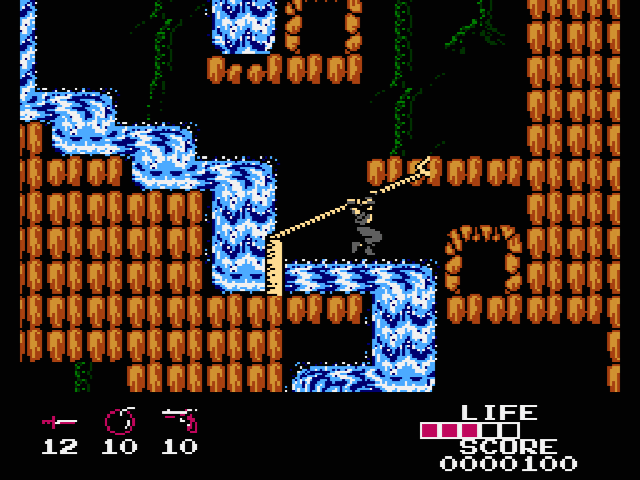
Arumana no Kiseki (literally “The Miracle of Almana”) is probably the most surprising entry on this list by virtue of the fact that it should have been localized. The game seems like it would have really appealed to western audiences. The main character is a blatant Indiana Jones knockoff, the plot borrows heavily from The Temple of Doom, and there’s even a mine cart section! Indiana Jones is popular worldwide for a reason, and the action-based gameplay of Arumana no Kiseki would have resonated well with audiences anywhere. The game – which could be described as a vertically-scrolling platformer – tasks players with exploring six narrow caverns. During their adventure, players will encounter everything from giant spiders to hydras, but they will be able to dispose of them with handguns, knives, bolas, bombs, mines, and crystal balls. The primary mechanic in the game revolves around the hero’s grappling hook which is necessary for him to ascend through the caves. A similar play mechanic was used in Konami’s own Roc’n Rop earlier in the decade, and it helps the game stand out from other platform games that rely entirely on running and jumping. The game has its quirks and the grappling hook can take a while to get used to, but Arumana no Kiseki deserved to reach a wider audience. If you can’t find a way to play the game, you should at least make an effort to listen to the soundtrack. It’s 8-bit Konami at their finest.
5
Otocky
1987
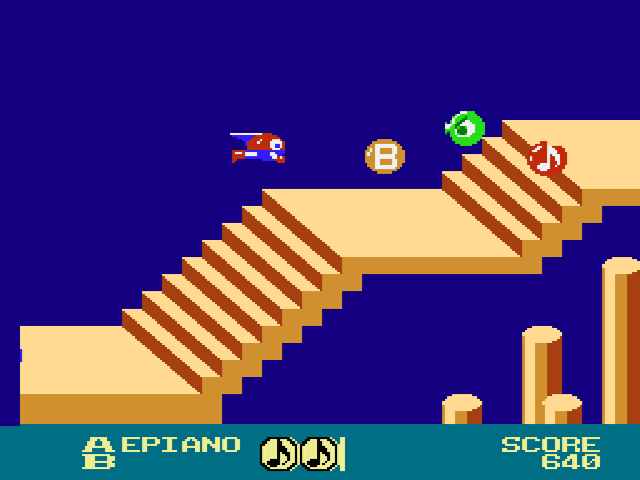
Games like Otocky are why this list exists. It looks like a simple, side-scrolling shoot ’em up, but its one of the most unique games of its era and was among the first games to use procedural generative music. The game could almost be viewed as a precursor to Sega’s Rez. The player’s spaceship is armed with a ball that can be fired in eight directions, and each direction corresponds with a different musical note. The notes that play when the ball is fired are quantified such that they match the beat of the backing track. The ball is used to destroy enemies and collect various objects, but it also allows players to improvise music while playing the game. The quality and variety of the musical instruments is quite stunning given the era it was released. In various levels, you’ll hear sounds based on keyboard, brass, percussion, and synthesized instruments. If players complete enough levels, they unlock a music editor that lets them freely compose melodies without worrying about enemies. The game didn’t make much of a splash upon its release and never received any sequels, but it was ahead of its time in many ways and the designer of the game went on to produce several other sound-based games, including SimTunes and Electroplankton.
4
The Mysterious Murasame Castle
1986
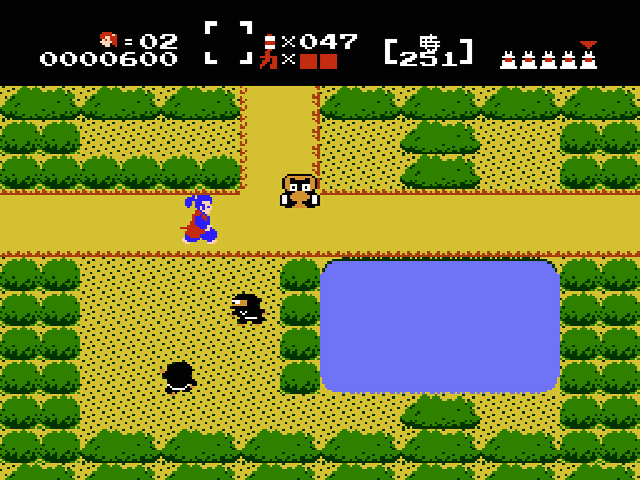
One of the first titles developed for the Famicom Disk System, The Mysterious Murasame Castle follows a samurai apprentice named Takamaru on his mission to infiltrate a secret castle in Edo period Japan. The graphics, characters, and soundtrack all borrow heavily from existing Japanese culture, which helps explain why the game was confined to Japanese shores until it hit the 3DS Virtual Console in 2014. The game employs an overhead view in the style of Zelda, but the progression is more linear and the action is a lot more intense. Enemies will jump out of bushes, emerge from lakes, and drop down from ceilings. They’ll occasionally attack in formation and can throw projectiles at you from all angles. The game is often filled with so many enemies that the game starts to feel like a shoot ’em up. Players are armed with a katana that can be used to block enemy shurikens. They’ll also be able to use their own shurikens as well as lightning-themed explosives and a cool invisibility cloak. The Mysterious Murasame Castle is often described as an open world adventure game, but it’s really an action game at its core. References to the game have been made in many other Nintendo titles, but The Mysterious Murasame Castle is just begging for a proper sequel. Hideki Kamiya of Platinum Games has even expressed his interest in reviving the series.
3
Ai Senshi Nicol
1987
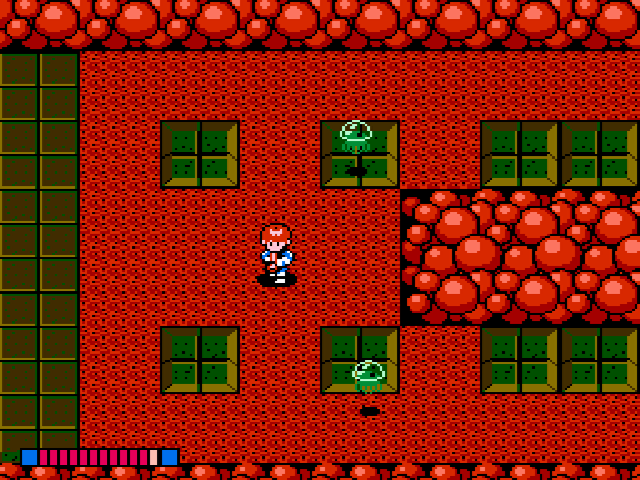
Ai Senshi Nicol translates to “Love Warrior Nicol.” Appropriately, the game follows Nicol as he battles invading aliens in order to rescue his kidnapped girlfriend. As an adventure game played from an overhead perspective, comparisons to Zelda are unavoidable. With that said, Nicol plays more like a cross between The Guardian Legend and StarTropics. The game consists of seven massive mazes, and each is punctuated by an impressive boss battle. Nicol is armed with a blaster and has amazing jumping capabilities, and he can also make use of several items to improve his situation. Power shoes increase his walking speed, pants protect him against lava and water damage, and energy tanks naturally increase his health. Nicol also finds items to increase the range and power of his weapon. The various environments in Ai Senshi Nicol make great use of the Famicom’s limited color palette, and the soundtrack puts the extra sound channel of the Famicom Disk System to good use. It’s a shame that the game was never released outside of Japan, but the text is in Engrish so there is no language barrier for anyone who wants to check it out.
2
Vs. Excitebike
1988
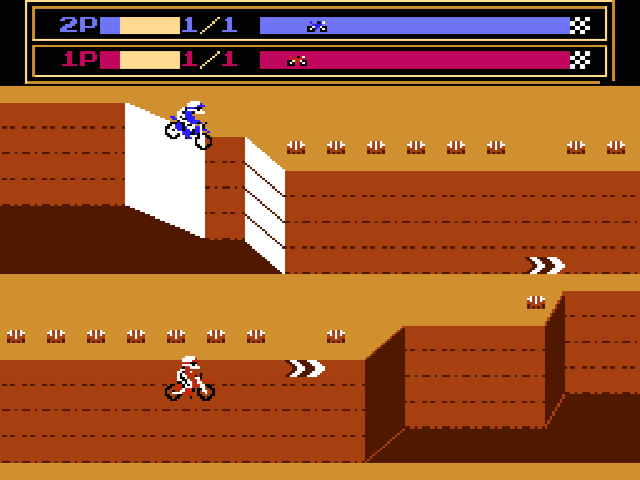
In Excitebike, players either race against the clock or against other motocross riders through tracks loaded with obstacles and killer jumps. Even though the gameplay is incredibly simple, there are also strategic elements in play. For example, getting tremendous air off jumps can give you an advantage over your opponents, but if you don’t land properly you could end up losing speed or wiping out altogether. You’ll also have to be careful not to ride too hard, or you’ll find yourself stalled on the side of the road with an overheated engine. In addition to the standard tracks, you also have the ability to create your own courses! The track editor is surprisingly comprehensive (with over 20 obstacles to choose from) and contributes greatly to the replay value. Vs. Excitebike improves upon its cartridge-based brother in a couple of ways. Most significantly, the game allows two players to compete against each other like they could in the 1984 arcade release. This was one of the first examples of split-screen gameplay in a console game. The number of courses in the game was also increased from five to seven, and a new bonus stage was included that challenged players to jump over stacked semi trailers. The user-created courses were also given a brighter spotlight. Vs. Excitebike took advantage of its rewritable disk format and actually gave players the option to save their courses without the need for the external Famicom Data Recorder peripheral. I wasn’t too fond of the new color pallet and missed the music from the original Excitebike, but there is little doubt that Vs. Excitebike is a more complete package and the better game overall.
1
Super Mario Bros. 2
1986
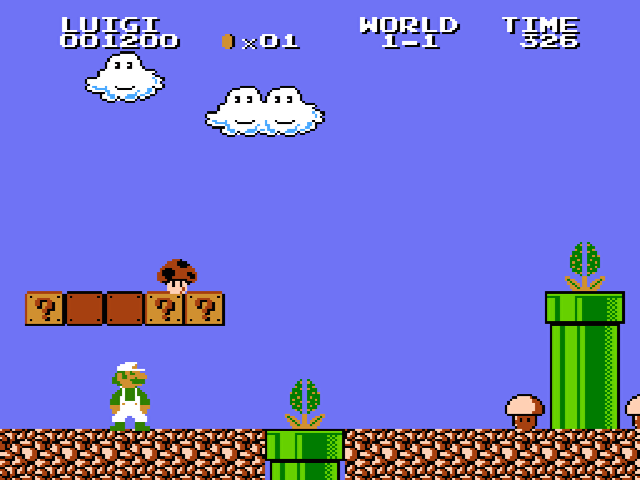
Super Mario Bros. was the single biggest game of its era, so the expectations for the sequel couldn’t have been higher. Unbeknownst to most American gamers, Super Mario Bros. 2 was released in Japan for the Famicom Disk System less than nine months after its legendary predecessor. The sequel reused many of the assets from the original, and most of the music, sprites, and backgrounds were completely unaltered. The game could perhaps be described as an ultra-challenging expansion pack of sorts. It was the first game to give Mario and Luigi different abilities, but most of the new concepts introduced in the sequel (including poisonous mushrooms, upside down pipes, wind storms, backwards warp zones, and the prospect of facing two Bowser’s at the end of the game) served to increase the game’s difficulty. Unfortunately, Nintendo felt that the game was a little too difficult and were worried about how American gamers would respond to it. Instead of releasing the “real” Super Mario Bros. 2, Nintendo opted to give a makeover to an obscure Arabian-themed platformer called Yume Kojo: Doki Doki Panic and released the game in the west as Super Mario Bros. 2 in 1988. The “real” Super Mario Bros. 2 was never released on the NES, nor was a cartridge version developed for the Famicom. The game would eventually be included as part of Super Mario All-Stars on the SNES where it was appropriately subtitled The Lost Levels.

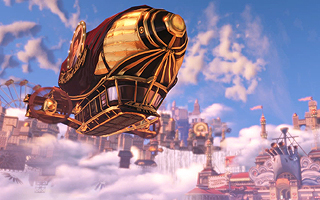
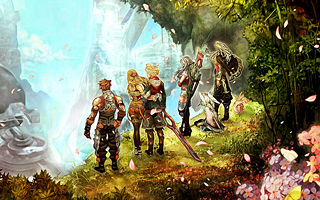
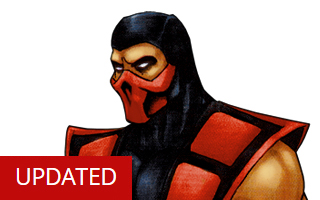

Do you agree with this list? Let us know what you think by leaving a comment below. Your opinion matters!